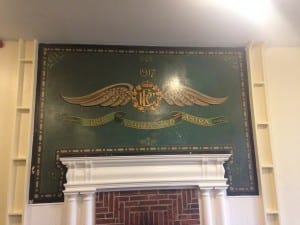Friday 31st of January was our first early morning session at the Grandstand, and for most of us, it was the first time we had the opportunity to explore the site in a lot more detail. Throughout the week, I began to feel extremely nervous about the module because it is a subject that is completely out of my comfort zone and I felt a lot of pressure about creating something for a very different style of theatre to what I was used too. However our seminar the day before made my worries settle slightly as we spoke about our personal definitions of we thought ‘Site Specific’ was as well as reviewing some professional practitioner explanations. From this exercise, it was evident that this module leading to the creation of a final ‘performance’ would be a journey and very much an open-minded process where extensive exploration and discovery of the site will frame for our ideas into much further development. Something that will take a lot of research, hard work and time.
As I arrived at the site, I didn’t expect the building to radiate such a strong sense of abandonment and sadness. I suppose the miserable weather didn’t help this and there are definitely a few people in the group who will disagree but looking closer at the exterior of the building, it most definitely felt lifeless. Our first task was to look around the outside of the building, capturing images of the surrounding areas and other interesting parts of the landscape that intrigued us.


The images below are just a few of the outside spaces on the site that I found rather captivating. This is generally due to the mood that is exposed from each space but also the potential they all have to inspire or even develop a ‘performance’. The discovery of these spaces made me think more about the aims of the module and how working with non-theatre venues such as like the Grandstand could possibly allow for a wider range of concepts and influences for ‘art’… ‘Not only does the use of non-theatre venues contribute to ‘an enquiry into what theatre is and might be’, it also incorporates ‘a set of productive spatial metaphors, whereby practitioners use their focus on geographical space to explore a range of theatrical, conceptual, political and virtual spaces. Thus the potentially restrictive specificity of the work is expanded to allow for ambiguity and multiplicity’ (Wilkie, 2008, p. 100) in (Pearson, 2010, p. 9).


In the next part of the session, we went inside to take a tour of the rooms within the Grandstand. This again allowed us to take pictures of that we found exciting or interesting. There were a few rooms within the main building that seemed as cold and drab, just like how I felt about the outside of the site. However in complete comparison to this, there were many rooms that were filled with outstanding character and identity. Roms (2008, p 115) stated that it wasn’t just the location that provides a performance with ‘a sense of identity’ but it is the memories and historic associations that mean a great deal (Pearson, 2010, p. 9). With reference to these images, I agree with this idea as the character that I feel oozes from these rooms definitely have a strong connection to the World Wars. This piece of art work will be something I would like to do some further research on when visiting the Lincoln Archives as I feel it may reveal unknown facts and inspire us all towards a potential concept and War themes.

We later got into groups to produce a 2 minute experience within a space on the site. This was difficult for me as I had made a connection to many of the spaces. From taking a picture of stained glass windows, I discovered a charming, green tiled, narrow corridor that myself and the rest of the group instantly connected to. One side of the corridor was tiled and had stained glass and on the other side were huge windows, which we used for our main idea. We used the windows to blow hot breath and write words we felt described the building. We stood on the outside of the corridor whilst the rest of the group were standing in the corridor. Our reasoning and concept for this was that the writing would eventually fade everytime but we would keep writing over it, as if we were trying to keep hold of the building’s character and history that seems to be forgotten and somewhat lost.


I look forward to studying and researching more into the building itself with particular focus on some of the art work and architectural remains, such as the ones that have Latin phrases which can be translated and further explored.
‘Site specific’ performance engages with the site as a symbol, site as a story-teller, site as a structure’ (Wilkie, 2002, p. 150) in (Pearson, 2010, p. 8)
References:
Pearson, M (2010) Site Specific Performance. New York: Palgrave Macmillian.
Roms, H. (2008) ‘Staging an Urban Nation’ in Holdsworth, N. and Luckhurt, M. (eds) Contemporary British and Irish Drama. Oxford: Blackwell.
Wilkie, F. (2002) Mapping the Terrain: a Survey of Site-specific Performance in Britain. New Theatre Quarterly. 18 (2) 150.
Wilkie, F. (2008) ‘The Production of Site: Site-Specific Theatre’ in Holdsworth, N. and Luckhurt, M. (eds) Contemporary British and Irish Drama. Oxford: Blackwell.








